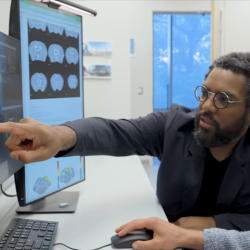Bridging Cultures and Supporting Collaborations
Q&A with Brain and Behavior Institute Founding Director Betsy Quinlan
As the founding director of the University of Maryland’s Brain and Behavior Institute (BBI), Elizabeth “Betsy” Quinlan wants to foster the development of innovative, multidisciplinary approaches to neuroscience. She wants to inspire and encourage neurobiologists, engineers, computer scientists, cognitive and developmental scientists, linguists and public health experts to team up and tackle some of humanity’s most pressing issues around brain disease and neurological health.
To do that, Quinlan is outlining a path for the BBI that offers resources and incentives to this research community for multi-lab team science and that forges new opportunities to think outside the box.
A professor in the Department of Biology, Quinlan came to UMD in 2001 as an assistant professor, following postdoctoral fellowships at Brown University and the University of Virginia. She gained acclaim as a neuroscience researcher for pioneering the use of sensory deprivation to promote plasticity and “rejuvenate” neural circuits in the brains of mammals.
For the past five years, Quinlan has been at the forefront of efforts to build a collaborative community among the more than 100 UMD researchers interested in brain health and behavior research. In 2015, a campus initiative to support brain and behavior research was born, and Quinlan was named co-director of the initiative in 2018. From 2015 through 2020, that initiative provided $1.75 million in seed grants to 27 projects and yielded a 734% return on that investment through external funding from federal grants, private foundations and corporations.
In January 2021, the initiative transformed into the Brain and Behavior Institute, with Quinlan at the helm as its director and Clark Leadership Chair. We sat down with Quinlan to learn a little about her and her plans for leading the BBI and its enthusiastic community.
What drew you to science?
My first professional ambition was to be a writer. But the process of scientific discovery always excited me, and I learned that the right solution to a scientific problem was often simple and elegant. I was introduced to neuroscience as an undergraduate at the University of Iowa. Learning that the complexities of the brain could be understood through physiology, anatomy and genetics inspired me to pursue a career in neuroscience.
You have a reputation for being fearless in your approach to taking on challenges, can you tell me about that?
Well, I appreciate that—in my opinion, fearlessness is relatively easy in neuroscience, because it is a problem-based discipline that addresses highly significant problems. Why is the incidence of autism on the rise? How can neuroscience help to end the substance abuse pandemic? How do we improve diagnostics or therapeutics for Alzheimer's? How can we promote healthy aging to enhance quality of life and mitigate cognitive loss?
One way to tackle these problems is to go out fearlessly and recruit a broad range of tools and perspectives. Neuroscientists use genetics, physiology, anatomy, imaging, behavior, computer science and engineering—all of these perspectives are crucial. A multi-faceted approach might feel fearless, but it is also vital to understanding something as complex as brain function.
What do you see as some of the challenges of bringing such diverse perspectives under one umbrella?
There is a general acknowledgement that discovery can be enhanced by multidisciplinary approaches. However, as scientists, we are often evaluated on our contributions to a specific research field. Bringing together diverse perspectives means accounting for different evaluative criteria and increasing the motivation for team science. Over the last five years, I’ve learned that collaboration across departments or campuses is facilitated by understanding the differences in cultures and providing appropriate incentives.
How do you see yourself overcoming these cultural challenges?
My job as director is to envision how individuals’ expertise might complement each other, to help inspire researchers to work across disciplines, and to provide administrative and development support to enhance our team approach to neuroscience.
Inevitably, when you recruit people to join a team, you're also asking them to deemphasize their independence. To overcome that sacrifice, it’s important to ensure that the scientific focus is one that excites and inspires people and that support for collaborations is in place. I follow this model in my own lab, and the Brain and Behavior Initiative was enormously successful in this. The initiative inspired people to generate highly creative proposals and to collaborate with those who they may not have otherwise considered as collaborators without the BBI’s encouragement to extend themselves.
I am committed not only to continuing this approach to bridging the cultures of different disciplines but to providing further administrative and development support to foster team science. Our goal is to continue to use the seed grant mechanism to establish new collaborations that are long-lasting and to facilitate the translation of BBI seed grants into external awards. I have an excellent team, including specialists in grant development and grant administration, that will help shepherd this translation. Although we have a rich and diverse funding in neuroscience on the College Park campus, most of these dollars go to a single PI [principal investigator] or to work done in a single lab. BBI represents an exciting opportunity to expand this success into multidisciplinary, multi-PI awards.
What are your first steps?
One of the foundational pillars of the BBI is the promotion of experimental and analytical tool development to study the brain and behavior. That will not change. But our strategy moving forward will be to leverage our strengths and concentrate our resources on a small number of well-identified research themes. Right now we are gathering data and meeting stakeholders to identify how our key strengths align with the most pressing needs in neuroscience research to maximize our contributions.
I am fortunate there is great enthusiasm across campus for elevating and expanding neuroscience through the BBI. The Institute is supported by the provost, UM Center for Economic and Entrepreneurship Development, the vice president for research, the Clark Foundation, and the deans of six colleges and schools. I am also bringing together people from a range of disciplines that contribute to neuroscience across different scales—from the reductionist perspective of molecular biochemistry up to scientists who focus on large group interactions. The BBI will generate opportunities for collaboration by bringing these people together.
From 2018 to 2020, you were co-director of the MPowering the State initiative on Brain Health and Human Performance, which also fosters collaboration in neuroscience. What is the distinction between that initiative and BBI?
MPower initiatives fund collaborations between laboratories at the University of Maryland, College Park and the University of Maryland, Baltimore. These collaborations tend to favor work that could be translational or utilize a tool that is available on one campus but not on the other. I am excited to bring my experiences with bi-campus translational projects to the BBI. Both within-campus and across-campus collaborations offer great opportunities to expand existing strengths in neuroscience research, education and training at College Park.
All this, and you still run your research lab. How do you unplug?
I play tennis and kayak in the summer, ski in the winter, and I try to hike on the weekends year-round. We have a family house in Anchorage, and one of my favorite traditions is fat tire biking in the snow on New Year’s Day.
###
About the Brain and Behavior Institute (BBI)
The BBI aims to elevate the university’s research and teaching programs in neuroscience and promote innovative, multidisciplinary approaches to solve the most pressing problems of nervous system function and disease. The BBI is administratively housed in the College of Computer, Mathematical, and Natural Sciences and supported financially by the Office of the Provost, UM Center for Economic and Entrepreneurship Development, A. James & Alice B. Clark Foundation, Division of Research, CMNS, A. James Clark School of Engineering, College of Behavioral and Social Sciences, School of Public Health, College of Education, and College of Arts and Humanities.
Writer: Kimbra Cutlip
Media Relations Contact: Abby Robinson, 301-405-5845, abbyr@umd.edu
University of Maryland
College of Computer, Mathematical, and Natural Sciences
2300 Symons Hall
College Park, Md. 20742
www.cmns.umd.edu
@UMDscience
About the College of Computer, Mathematical, and Natural Sciences
The College of Computer, Mathematical, and Natural Sciences at the University of Maryland educates more than 9,000 future scientific leaders in its undergraduate and graduate programs each year. The college's 10 departments and more than a dozen interdisciplinary research centers foster scientific discovery with annual sponsored research funding exceeding $200 million.








